Samaaro + Your CRM: Zero Integration Fee for Annual Sign-Ups Until 30 June, 2025
- 00Days
- 00Hrs
- 00Min
The event technology landscape is rapidly evolving and is influencing every facet of event planning, execution, and experience. From AI-powered matchmaking to immersive AR/VR experiences, technology is elevating the attendee experience and influencing how success is measured by industry professionals.
As we look toward the year 2025 the adoption of advanced event technology is no longer an option, this has become an avenue to stay ahead of the competition. In this blog, we share the most exciting event technology trends and predictions that will shape the future of events resulting in better engagement, improved networking and better ROI for organizations and attendees alike.
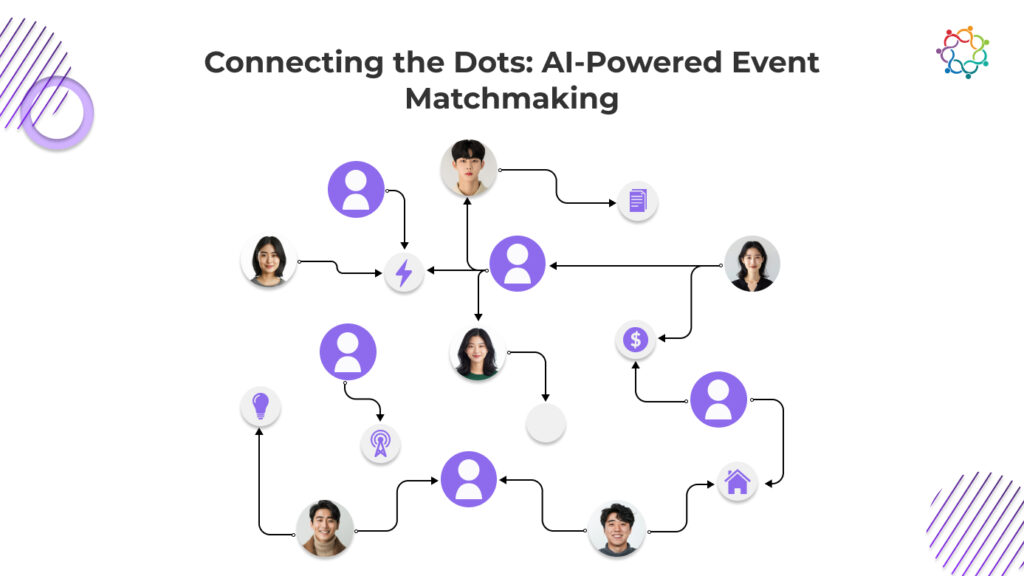
Connecting people at events, while it sounds like an easy task, is one of the hardest tasks for event professionals to champion, but it’s something event attendees expect. Traditional networking often relies on random meetups, social media, or manual/flipbook searches that can result in missed connections and opportunities. AI is introducing intelligent event networking and has also become a quiet but trustworthy ally in building value-based connections between people based on interests, expertise, and goals.
For Attendees:
For Organizers:
As AI emerges as a common denominator in the event matchmaking and networking process, planners can elevate their events into dynamic purpose-based hubs of meaningful engagement and ensure they leave with the key connections and insights from beyond the event.
Smart Badges & Wearables as a Part of Seamless Event Experiences
Event technology has been evolving rapidly and smart badges and wearables are continuing to provide value to attendee experiences and contribute to meeting planner operational efficiencies. These wearables are changing the way that organizations plan event logistics; they are speeding up check-ins, making networking easier, and giving a better picture of data collection.
Key Innovations in Event Wearables
The smart badge is a wearable that has RFID (Radio Frequency Identification) or NFC (Near Field Communication) technology. This badge gives a contactless check-in. Attendees will simply tap their badge to enter the venue; they don’t have to pay attention to long lines or having somebody check their credential.
Organizers can utilize wearables that can be tracked using IoT-enabled standards for their attendees to monitor their movements throughout the event. The data can tell organizers which sessions shared the highest attendance, which exhibitors received the highest traffic, or where the attendee clusters were through the event.
Smart badges and wearables can be interfaced with event apps to allow event planners to notify event participants based on their preferences and behaviour. Based on the information gathered, the system can notify the event participant on information on sessions, networking opportunities, and exclusive offers to ensure that each participant participates in a personalized event experience.
Smart wearables enhance gamification and audience engagement capabilities. Attendees can respond to live polls or other networking activities such as scavenger hunts or reward-based networking activities via their badges. A few events have even livened event experience through badges with LED capabilities that change colour to reflect their desires to network with another attendee.
Every interaction made with a smart badge brings valueable insights. Overall, organizers can track engagement, which attendees are engaged at sessions, and which booth locations are receiving visitors, allowing organizers to learn something which can be incorporated to improve their strategy at future events.
As with any technology which collects attendee data, security and privacy is critical. Smart event platforms lead with security demonstrations and by ensuring that all data collected (from badge deployments and registration) is encrypted. They can also offer opt-in tracking options for all purposes of attendee data collection, security, and personalization.
Why Smart Badges Are Revolutionizing Events
For Attendees:
For Organizers:
Smart badges and wearables have transitioned from a clever tool that makes life easier, to an essential tool for delivering a frictionless, data-driven, and engaging event for attendees.
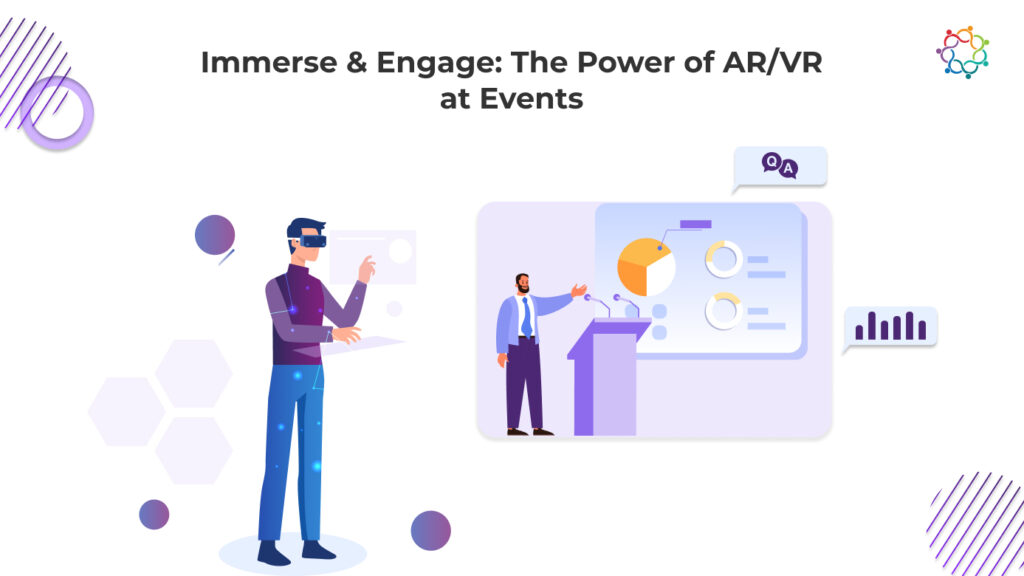
Augmented Reality and Virtual Reality are driving attendee engagement in events. They create immersive, and interactive environments. Attendees need to see the technology presented in a non-traditional event format, providing for deeper engagement, expanded – value networking, and more memorable attendee experiences.
Key Advances in Augmented and Virtual Reality for Events
Immersive Product Demonstrations
AR and VR-powered booths allows for attendees to experience the brand or product in a fully interactive 3D space. Rather than just being shown some static displays, attendees can interact with product features, be exposed to functionalities and even watch real-world situations- all without needing a physical sample. This applies to businesses like automotive, real estate and tech where the hands-on experience is impactful.
Virtual Venue Tours
Events can provide pre-event virtual tours via VR for attendees to see physical spaces, including exhibition halls, meeting rooms, and relaxation/networking lounges prior to arrival. This improves event planning and reduces obstacles to accessibility by making it easier for attendees to plan their schedules to maximize their time.
New Networking Opportunities
Virtual networking spaces offer new opportunities for hyperconnectivity through the experience of avatars and holograms bringing people together beyond geography. Virtual networking spaces simulate traditional face-to-face conversations with spatial audio and gesture-based communication with features like a virtual business card exchange to make virtual networking experiences more human-like, vibrant and compelling.
Gamified Experiences
Augmented reality and virtual reality are rewarding because they allow events to make their experiences more gamified than ever before. Attendees can join AR scavenger hunts, interact with challenges and compete in fun, exciting VR contexts that prompt attendees to explore through curiosity and engagement. These experiences keep attendees engaged but also create tours of experiences for foot traffic in desired locations as an example in an exhibitor booth or sponsored activation.
Training and Education
We are seeing an uptick in VR-powered training modules expanding learning formats from conferences and workshops. Attendees can get engaged in simulations with hands-on activities, practicing real-world scenarios, or interact with 3D models that help recall information, etc. Many industries such as healthcare, engineering, and aviation are employing VR-based experiences to practice in a secure and risk-free training format.
Why AR/VR is Transforming Events
For Attendees
For Organizers
AR/VR allow event organizers to create unforgettable experiences by combining the physical and digital realms, allowing engagement and excitement for attendees throughout the entire time experience!
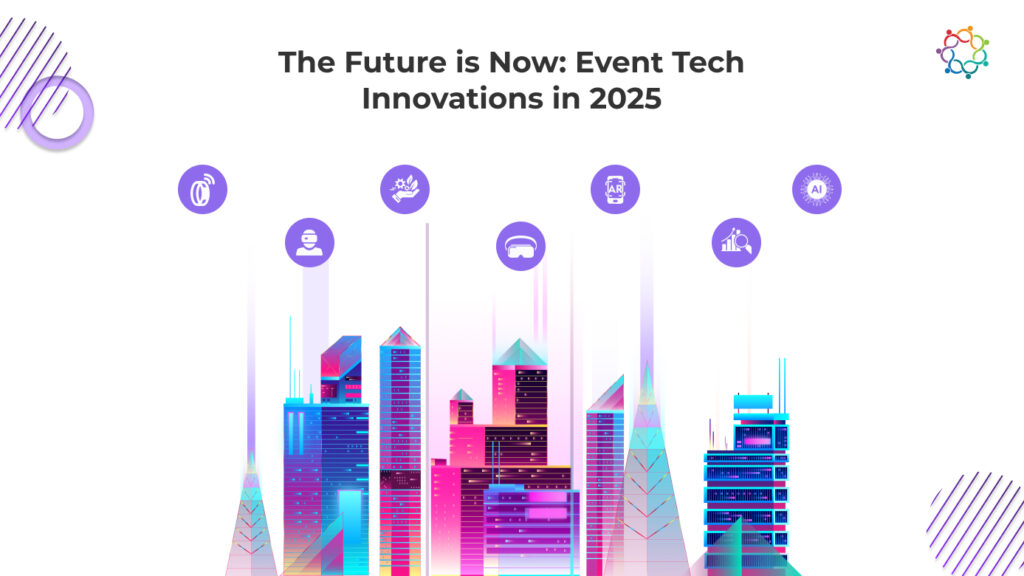
Virtual Spaces for Events
No event is ever again limited to a physical space. The Metaverse allows you to rely on an engulfing 3D virtual space and build it entirely from scratch! And attendees can enter from anywhere on earth! The Metaverse allows speakers to enter a virtual exhibition hall; sit in on a keynote; interact with booths and crowdsource, and more.
Well, your guests won’t just be looking at a screen, they will interact through customizable digital avatars. Which makes networking exciting and creative. The avatars can move around the space, find others, chat with voice or text, present themselves to others in ‘a more engaging way,’ participate in group chat and/or video, etc.
The Metaverse can link an audience in a physical location to participants in a virtual space. The two groups can, together, share a real, interactive, ‘live’ experience. Participants in a physical venue may interact with the virtual audience through holograms, VR powered meetups, or the ‘digital twin’ of the metaverse.
Although there has been exciting innovation in this area, there still remains enormous potential for the industry to engage in Metaverse events that have obstacles to adoption, including:
-Accessibility. Not all the attendees can afford VR headsets or have the internet speeds to truly engage.
-Cost. While some companies and businesses are investing substantial capital in developing and maintaining metaverse environments, it will make it nearly impossible for smaller events.
-Learning Curve. Either attendee, as well as organizers have not found the entry into the metaverse (using a 3D space that has avatars) easily navigated and there remains an educational state of need, particularly for attendees.
For Organisers:
The metaverse is not just a fad; it is part of the future of events, inextricably linking the regretful distance between digital and physical interactions – unlocking extraordinary experiences.
Sustainability + Event Tech
With sustainability taking a priority, event tech is providing solutions to help reduce the environmental impacts of in-person and hybrid events. These tech-driven solutions eliminate harmful waste, reduce energy consumption, and provide opportunities for better sustainability-oriented events.
Key Developments in Sustainable Event Tech
Green Event Planning
More digital solutions are replacing printed materials, significantly reducing paper waste. Event apps, virtual itineraries, check-ins using QR codes, and digital registration options cut down on printing physical tickets, brochures, and handouts. In short, they increase sustainability in events.
Virtual and hybrid events
Event Organisers can significantly reduce airport emissions by offering specimens of remote attendance opportunities. Hybrid events mean organisers need fewer people travelling long distances while maximising global audience attendance, discussion, and networking in a real-time experience.
Sustainable Event Apps
Many event apps now have sustainability-focused features, such as carbon footprint tracking features, green travel suggestions and digital exhibitor content. Some platforms even compensate attendees for demonstrating sustainable behavior such as using public transportation or bringing reusable materials.
Data-Based Knowledge for More Sustainable Experiences
AI-enabled analytics tools can help you measure and reduce your event environmental impact. Organizers can track energy use, waste generation, and attendee mobility to make more informed decisions about the place, catering, and use of resources.
Why Sustainability Has Importance to Events
For Attendees:
For Organizers:
Using event tech for the purpose of sustainability, organizers can implement sustainable activities and experiences without losing engagement or efficiency.
The Growth of Event Data, Reporting and Analytics
Event data has manifested into one of the most valuable assets to help organize an event that can result in a more meaningful and engaging experience for attendees and best value for the organizer. Enabled by AI-driven insights in more recent years, the tools to capture or monitor event outcomes provide real-time tracking or reporting that helps event planners leverage data to make data-based decisions to enhance any event.
Key Developments in Event Data & Analytics
Applying Real-Time Data
Many events are leveraging IoT, RFID badges, and event apps to monitor participant movement, attendance and data related to participation in sessions and activities. For example, real-time data enables an organizer to make quick decisions on items such as adjusting how the room is set up, adding another hour to networking or assessing the usage of areas in that space. Predictive Analytics
Personalized Insights
Attendees today expect the ability to customize their experiences. Using an AI-based event platform provides suggestions about potential recommendations based on their level of interest, the number of sessions they have participated in (finding their favourites), and engagement level(rankings). The attendee has personalized suggestions based on sessions that are related to their original choices and potentially engaging sessions they would not have previously considered.
Data Visualization for Decision-Making
Interactive dashboards provide event planners ways to visualize complicated event data. Real-time heatmaps, attendee sentiment analysis, post-event reports offer value based easy to read summaries; events can consider this down the road so it could help improve their future event strategy.
Why Event Data Is Changing the Landscape
For Attendees:
For Organizers:
Through event insights and analytics, planners can better develop their outline of their events to be more engaging, more efficient, and recognized for its impact.
Conclusion
The event industry is primed for the technological revolution that will be released over the next few years. As we consider the event technology landscape in 2025, we will see more personalized, engaging, and utilizing data-based events.
At Samaaro, we are helping to meet and event planners with AI-enabled marketing, smart networking, and analytic capabilities – to plan high-impact events. If you want to optimize your engagement opportunities, efficiency in operations or assure your event is successful, Samaaro’s event technology solutions can keep you ahead of the game. Book the demo today to see how you can elevate your events to the next level with enabling event technology.
The UAE has emerged as one of the world’s premier destinations for events, attracting global brands, corporate gatherings, and high-profile entertainment spectacles. As a thriving business and tourism hub, cities like Dubai and Abu Dhabi host a vast array of events, ranging from corporate conferences to luxury brand showcases and cultural festivals. The UAE’s strategic location, excellent infrastructure, and diverse audience create immense opportunities for event organizers.
However, marketing and selling events in the UAE requires an understanding of the region’s unique cultural and business environment. From digital-first marketing approaches to respecting cultural sensitivities, event professionals must tailor their strategies for maximum impact. In this guide, we’ll explore the best practices for event marketing in the UAE, key audience insights, and how platforms like Samaaro can help event organizers succeed.
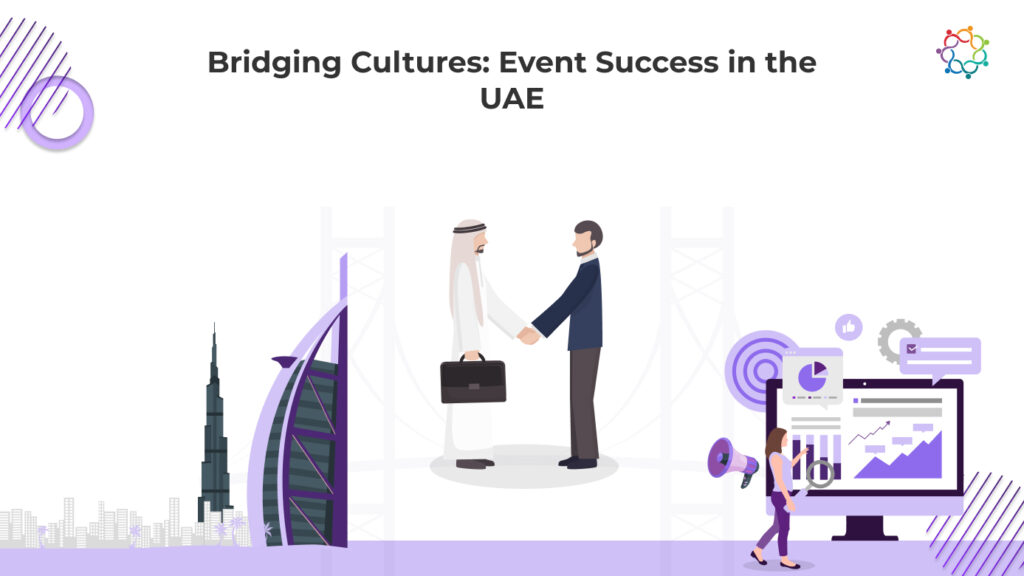
The UAE is home to a highly diverse population, comprising both Emirati nationals and a vast expatriate community. With over 80% of the population consisting of expats from countries such as India, the UK, the Philippines, and Egypt, event organizers must consider a multicultural audience when planning marketing efforts.
Key demographics include:
Understanding audience motivations helps in crafting targeted event messaging:
UAE audiences are highly active online, making digital marketing essential. Key insights include:
Event marketers must be mindful of:
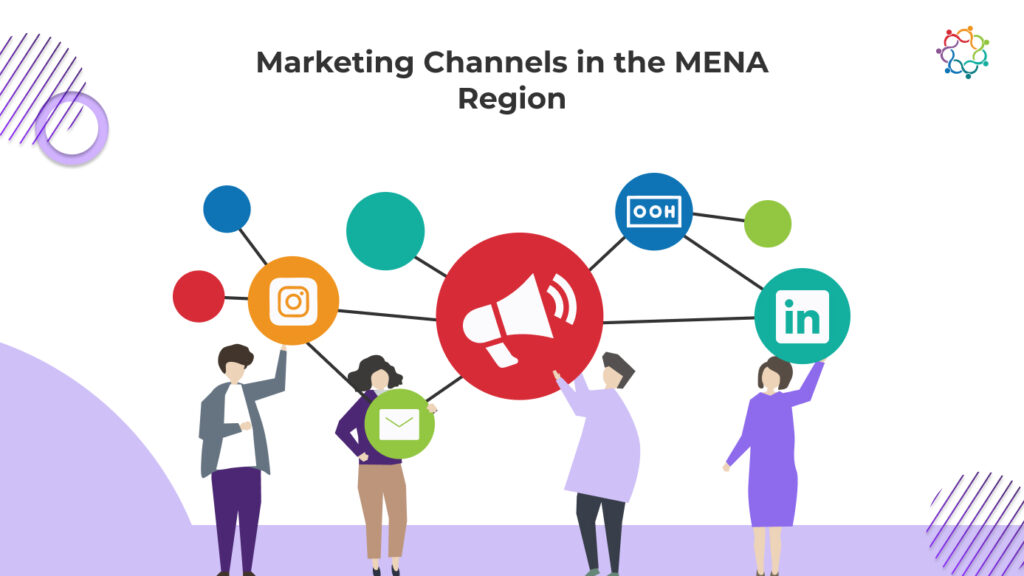
Social media plays a critical role in event promotions in the UAE. Event organizers should tailor their approach to each platform:
Paid advertising allows precise targeting and measurable ROI:
Email marketing remains a powerful tool for event promotions in the UAE:
Influencer collaborations can significantly boost event awareness:
Traditional marketing remains relevant, especially for high-end and large-scale events:
Radio and TV remain effective for mass outreach:
Strategic PR efforts help secure credibility and media coverage:
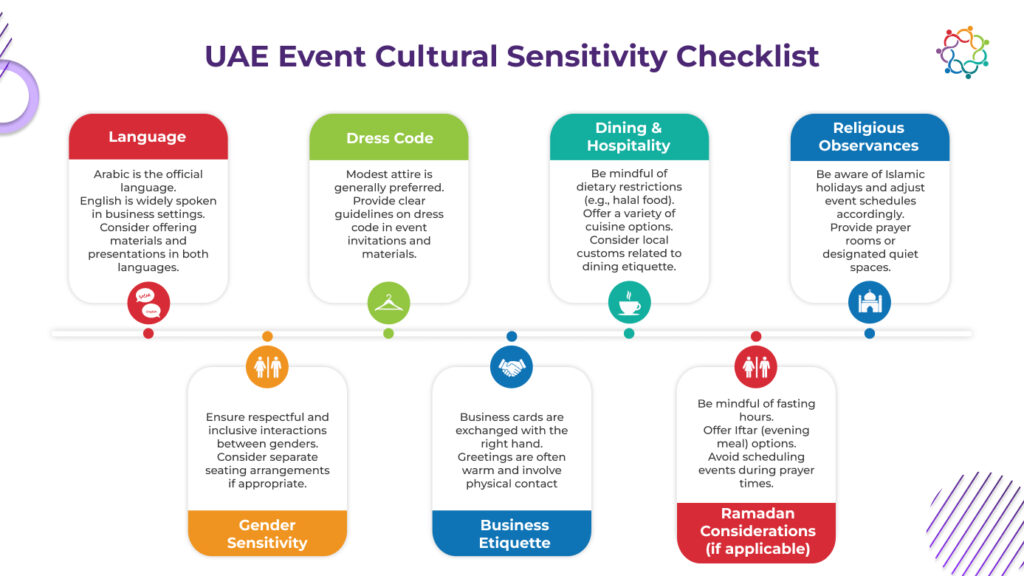
When hosting an event, understanding and respecting cultural nuances is key to creating an inclusive and engaging experience for all attendees. From language preferences to religious observances, every detail contributes to making guests feel comfortable and valued. Here’s how to integrate cultural sensitivity into your event planning:
Language plays a crucial role in effective event engagement. In regions where Arabic is the primary language, offering bilingual communication in both Arabic and English ensures that all attendees can fully engage with the event.
By addressing language diversity, you enhance accessibility and create a more welcoming experience for all participants.
Different cultures have varying expectations when it comes to attire and social etiquette. It’s important to:
Understanding these social norms helps in building trust and fostering a professional yet culturally appropriate atmosphere.
Food and hospitality are central to event experiences, and being mindful of cultural dietary preferences ensures that every guest feels accommodated.
Providing thoughtful hospitality not only enhances attendee satisfaction but also reflects respect for cultural diversity.
Religious customs and holidays can impact event attendance and scheduling. Being mindful of these factors is crucial for event success.
By taking religious considerations into account, you create an inclusive environment that respects the beliefs and traditions of your attendees.
Ensuring gender inclusivity in events is essential for fostering an environment of equality and respect.
By being proactive about gender sensitivity, you demonstrate cultural awareness and create an event experience that is comfortable and welcoming for all attendees.
Cultural considerations should never be an afterthought in event planning. By taking a thoughtful approach to language, dress codes, hospitality, religious customs, and gender inclusivity, you ensure that your event is truly engaging for a diverse audience. When attendees feel respected and valued, their engagement levels rise, leading to a more successful and impactful event.
The UAE is a global hub for business, innovation, and networking, making it an ideal location for corporate events. However, attracting the right audience and ensuring high attendance requires a strategic approach. Here are key tactics to drive corporate event attendance in the UAE:
Personalization is key to capturing attention in a competitive event landscape. A generic invitation may go unnoticed, but a well-crafted, personalized message can significantly improve response rates.
By making your invitations relevant and compelling, you increase the likelihood of attracting high-quality attendees.
One of the biggest draws for corporate events is the opportunity to network with industry leaders, potential clients, and like-minded professionals.
Emphasizing networking benefits in your promotional campaigns can significantly boost attendance rates.
Corporate professionals value insightful, actionable content that helps them stay ahead in their industry. To drive attendance, your event must offer engaging and relevant content.
Promoting the strength of your agenda will make your event a must-attend for professionals looking to gain knowledge and insights.
Providing unique and exclusive experiences adds an element of prestige and makes your event more appealing.
Offering something attendees can’t get elsewhere makes your event stand out.
Collaborating with industry organizations, media partners, and sponsors can significantly amplify event visibility and credibility.
Strong partnerships help extend your event’s reach and attract the right audience.
A well-structured incentive strategy can encourage early registrations and group attendance.
Incentives create urgency and provide additional motivation for people to sign up.
Technology plays a crucial role in enhancing event marketing, engagement, and overall experience.
Utilizing event technology ensures a seamless attendee experience and maximizes engagement before, during, and after the event.
Driving attendance at corporate events in the UAE requires a blend of strategic marketing, exclusive experiences, and cutting-edge technology. By personalizing invitations, providing strong networking opportunities, and leveraging incentives, you can attract high-value attendees and create a memorable event.
Marketing and selling events in the UAE requires a deep understanding of the region’s unique business culture, audience preferences, and engagement strategies. From crafting personalized invitations and leveraging networking opportunities to incorporating exclusive experiences and event technology, every detail matters in driving attendance and ensuring success.
Cultural sensitivity plays a crucial role in event planning. Whether it’s offering bilingual communication, respecting local customs, or providing tailored hospitality, adapting to the UAE’s cultural landscape enhances attendee experience and fosters stronger connections.
By implementing the strategies outlined in this guide, event planners can create impactful experiences that attract the right audience and deliver measurable success.
At Samaaro, we understand the complexities of event marketing in the UAE. Our AI-powered event marketing platform helps you streamline your outreach, personalize attendee engagement, and optimize event performance with data-driven insights. Book a demo today and see how Samaaro can help you elevate your event strategy in the UAE.
India’s event marketing landscape is evolving rapidly, driven by its diverse cultural heritage, digital transformation, and the growing demand for personalized experiences. With over 900 million internet users, many of whom prefer regional content, event marketers must adopt localized strategies to maximize engagement and attendance.
Traditional, one-size-fits-all event promotions no longer yield the best results. Instead, a blend of vernacular content, WhatsApp promotions, influencer collaborations, and region-specific outreach is essential to connect with India’s vast and varied audience. This blog explores the key strategies for event marketing in India in 2025, covering vernacular promotions, digital ad preferences, payment trends, and WhatsApp-based outreach to help event organizers drive success in this dynamic market.
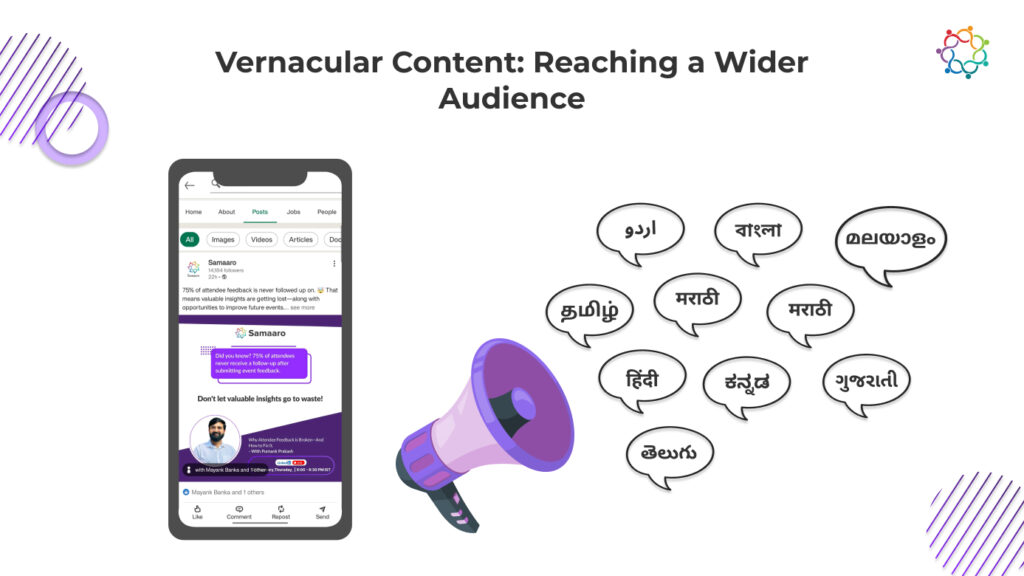
India is a multilingual nation where English is not the primary language for most internet users. According to a recent report, over 70% of India’s internet users prefer consuming content in regional languages. Platforms like YouTube, ShareChat, and Moj have witnessed a surge in regional language content, reflecting the shift away from English-dominated digital spaces.
To maximize event attendance, organizers must cater to this linguistic diversity by creating marketing materials that resonate with regional audiences. Research shows that vernacular content improves engagement rates and builds trust among attendees, especially in Tier 2 and Tier 3 cities.
Regional influencers play a pivotal role in connecting with local communities. Event marketers can collaborate with micro and nano influencers who have a deep cultural understanding of their audience. These influencers can create authentic event promotions in their native languages, significantly improving engagement and attendance.
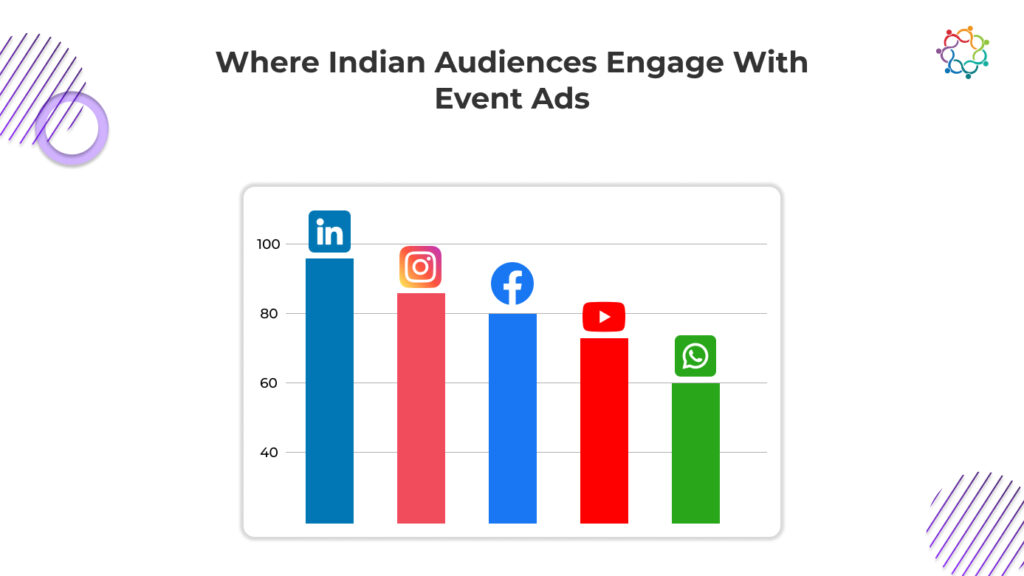
Understanding the platforms where Indian audiences engage the most is crucial for effective event marketing. The most popular digital channels for event promotions in 2025 include:
Event marketing in India thrives on building communities. Successful event brands create:
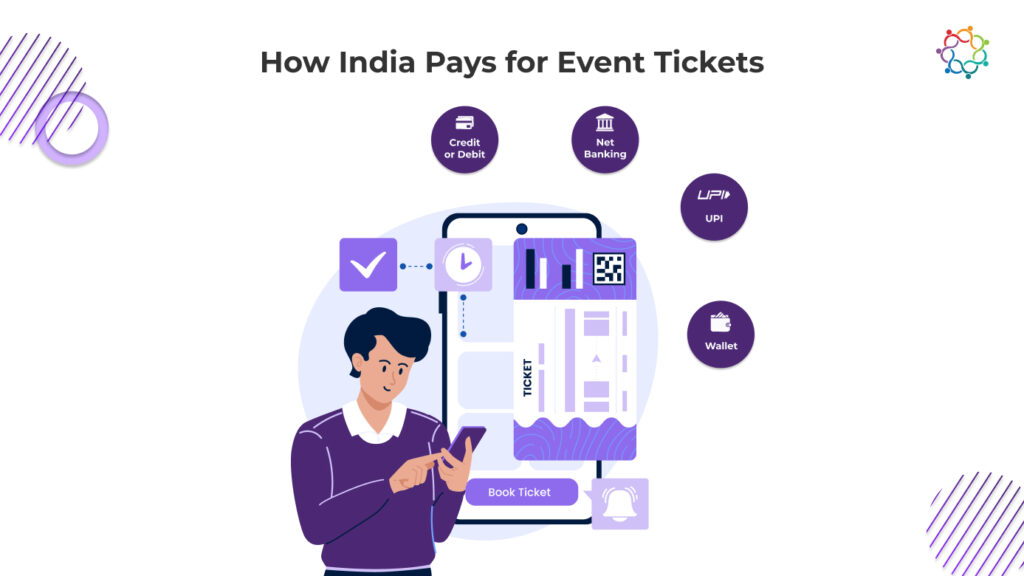
India leads in digital payments, with UPI (Unified Payments Interface) accounting for over 75% of online transactions. Event organizers must integrate UPI-based payments, QR codes, and mobile wallets for seamless ticket purchases. Other trends include:
With over 500 million active WhatsApp users in India, the platform is a key driver for event promotions. WhatsApp’s high open rates and direct engagement capabilities make it an invaluable tool for event organizers.
Influencers have become the backbone of event marketing in India. Brands are increasingly leveraging micro and nano influencers who have niche, engaged communities. Popular platforms include:
Marketing events in India requires a localized, multi-channel approach that incorporates vernacular content, WhatsApp marketing, digital payments, and influencer collaborations.
Samaaro’s event marketing solutions are designed to help organizers implement these strategies seamlessly. Key features include:
Are you ready to scale your event marketing in India? Explore how Samaaro can help you reach your audience effectively!
Getting people to register for an event is just the beginning. The real challenge is keeping them engaged and ensuring they actually attend. Many registrants lose interest due to lack of communication, unclear event value, or competing priorities.
Event nurturing is the process of keeping attendees engaged, excited, and committed leading up to the event. With strategic engagement, personalized communication, and the right technology, organizers can significantly reduce no-show rates and increase participation.
This blog explores why event nurturing is essential, how to segment and personalize attendee engagement, and the best tactics to keep registrants engaged until event day.
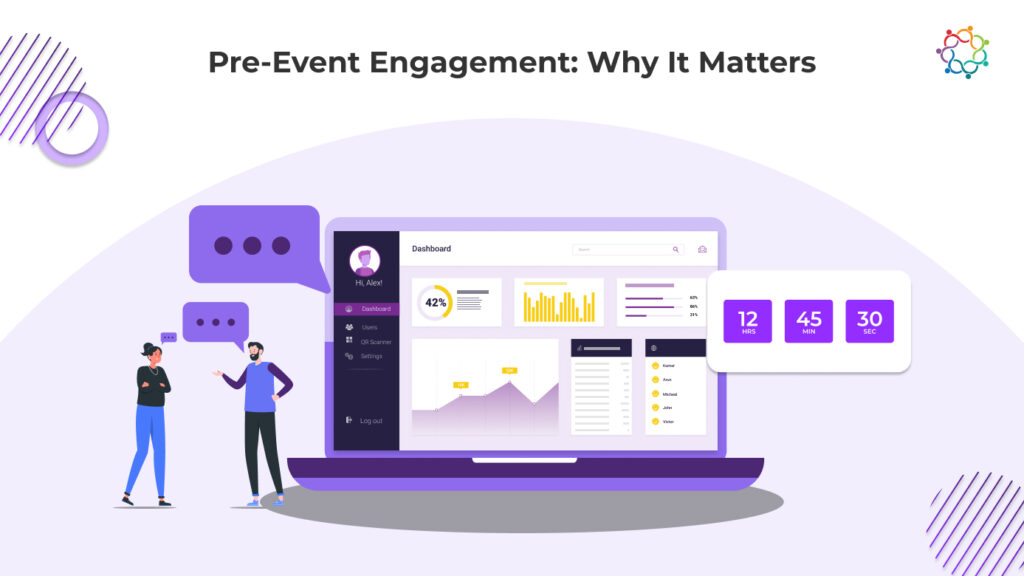
A successful event doesn’t begin on the day it takes place—it starts from the moment attendees register. Keeping registrants engaged before the event ensures they remain excited, prepared, and committed. Without continuous engagement, there’s a higher chance of drop-offs and reduced participation.
Many registrants drop off due to lack of interaction after signing up. Engaged attendees, on the other hand, feel more invested in the event and are more likely to show up.
Excitement drives attendance. Creating a sense of anticipation through exclusive sneak peeks, speaker announcements, and pre-event activities ensures attendees look forward to the event.
Frequent communication that highlights key sessions, exclusive content, and networking opportunities reinforces why the event is worth attending.
Pre-event networking opportunities, interactive content, and behind-the-scenes insights help attendees feel connected before the event even starts.
AI-powered engagement tools can track attendee interest levels and send targeted content based on behavior. Event apps, chatbots, and analytics dashboards help tailor engagement strategies effectively.
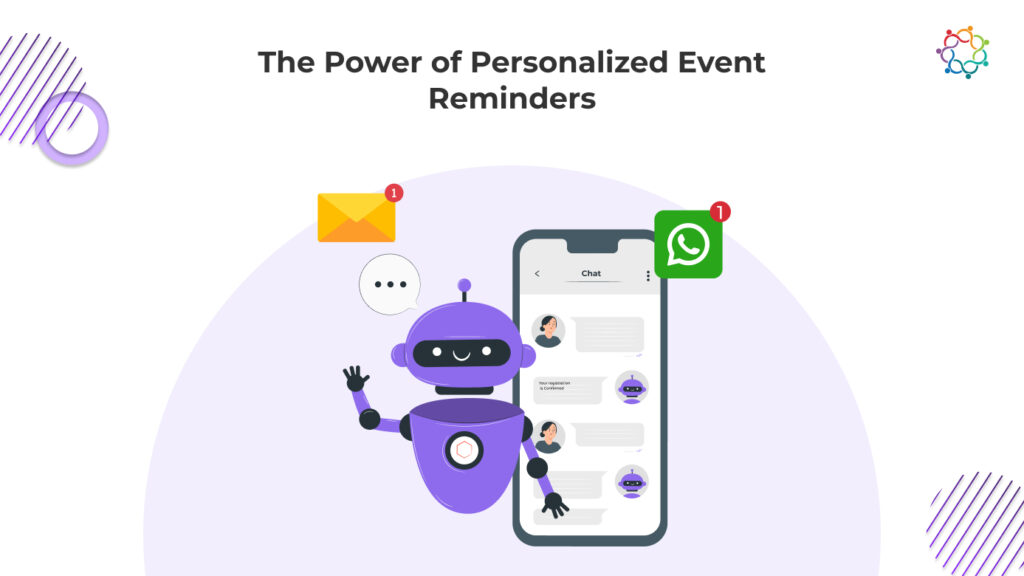
Every attendee has different expectations and interests when registering for an event. By leveraging automation and segmentation, organizers can provide a more personalized and engaging experience that caters to these individual needs.
Not all attendees are the same. By segmenting registrants based on interests, registration type, and past interactions, organizers can personalize content and outreach.
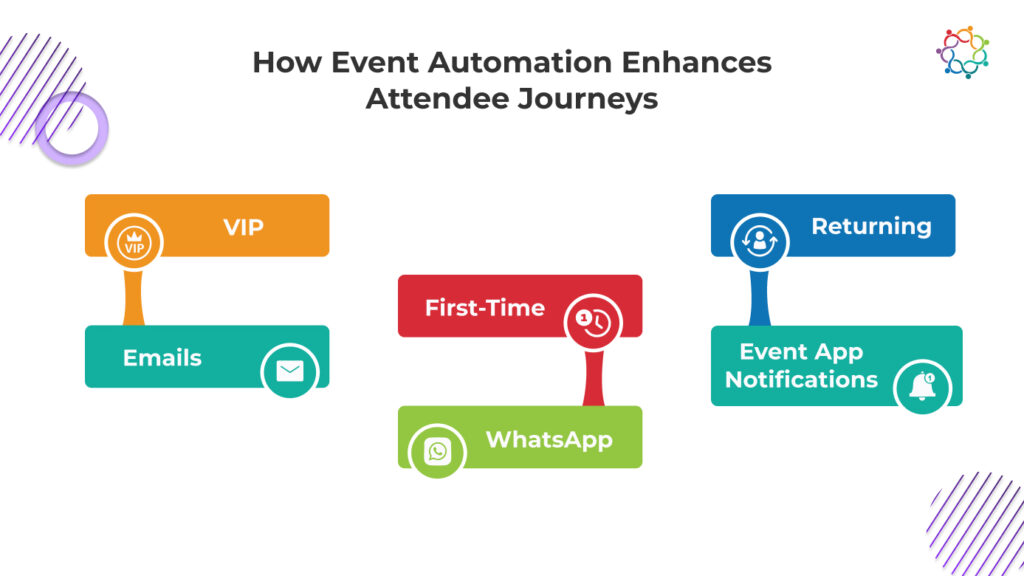
Once attendees register for an event, maintaining their interest and ensuring they don’t forget about it is crucial. A well-crafted reminder strategy goes beyond generic emails—it should be timely, interactive, and personalized to create a sense of anticipation. By leveraging multiple communication channels such as WhatsApp, AI-driven messaging, and engaging email sequences, organizers can keep attendees informed and excited about the event.
WhatsApp has become a powerful tool for real-time engagement. Unlike emails, WhatsApp messages have significantly higher open rates, making them ideal for sending reminders. Event organizers can use WhatsApp to provide quick RSVP confirmations, share direct links to the event platform, and even allow two-way communication where attendees can ask last-minute questions. Automated reminders sent via WhatsApp can also include countdowns, key session updates, and venue details to keep attendees prepared.
Emails remain a vital part of event nurturing when done strategically. Instead of sending generic reminders, a structured drip campaign can provide attendees with valuable insights leading up to the event. Personalized email sequences can include:
By offering engaging content rather than just reminders, emails become an exciting part of the event journey rather than an obligation.
Artificial intelligence can help refine event nurturing by sending reminders based on attendee behavior. AI-driven reminders can:
These smart, data-driven interactions ensure that reminders feel natural and relevant rather than intrusive.
Instead of plain text messages, interactive reminders can add an element of fun and engagement. Countdown GIFs, interactive polls, and sneak peeks into the event’s biggest highlights can make reminders feel more exciting. Offering exclusive content, such as behind-the-scenes footage or early access to event perks, can further enhance engagement and encourage attendance.
By implementing a multi-channel, personalized approach to reminders, event organizers can ensure registrants remain engaged, well-informed, and excited right up until the event day.
Keeping registrants engaged after they sign up is crucial to ensuring they attend. A well-planned engagement strategy can create excitement, build anticipation, and foster connections even before the event starts. Organizers should focus on delivering interactive content, exclusive insights, and personalized experiences to keep attendees interested and involved.
Keeping registrants engaged from the moment they sign up until event day requires a mix of personalized engagement, automation, and interactive strategies. Through AI-powered reminders, gamified participation, and exclusive pre-event activities, event organizers can significantly improve attendance rates.
Samaaro’s event marketing platform is designed to streamline this process with features such as:
Ready to maximize event engagement? Explore how Samaaro can help today!
Securing event registrations is just the first step—getting attendees to actually show up is the real challenge. Many organizers struggle with high no-show rates, often due to scheduling conflicts, lack of perceived value, or simple forgetfulness.
So how can event marketers bridge the gap between sign-ups and attendance? The answer lies in strategic engagement, data-driven reminders, and the use of behavioral psychology.
In this blog, we’ll explore why attendees drop off, how to implement effective event reminder strategies, the role of gamification, and on-the-day tactics to ensure maximum participation.
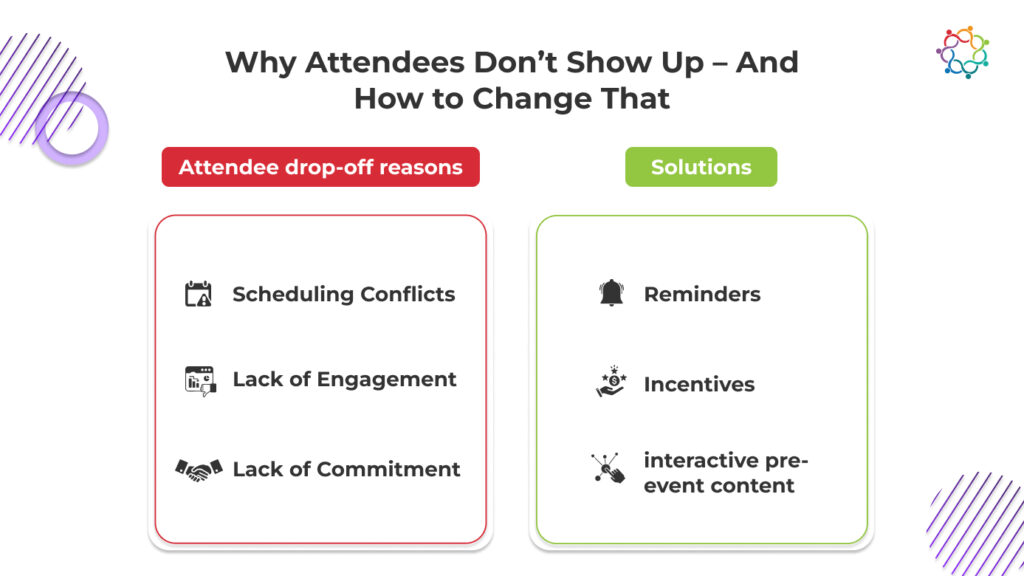
Understanding why people sign up but fail to attend is crucial. Here are the common reasons and how to counter them:
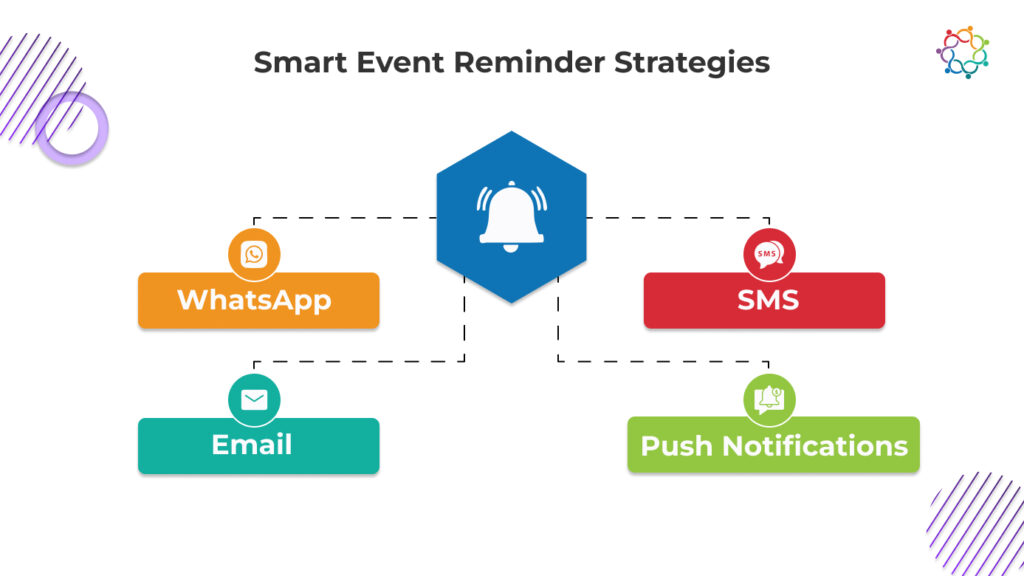
Traditional email reminders are often ignored. A multi-channel approach ensures better engagement.
Gamification adds an interactive and rewarding element to event participation.
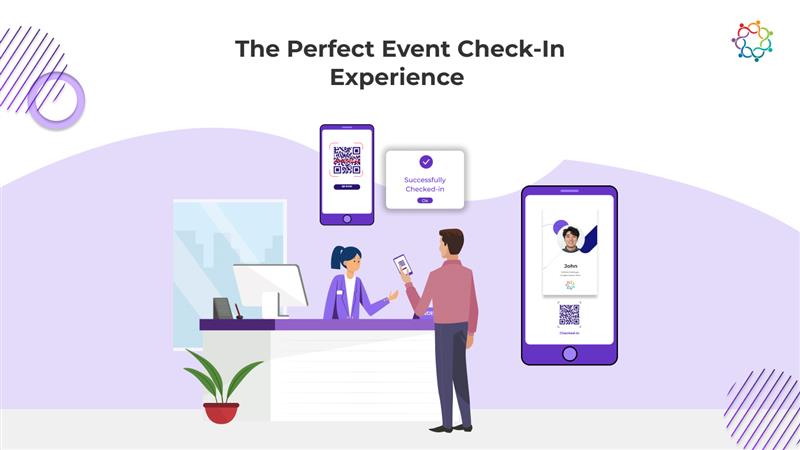
Even after reminding attendees, some may still hesitate to join. Keeping them engaged from the moment they check in is crucial.
Ensuring that attendees return for future events is just as important as getting them to show up in the first place.
Maximizing event attendance requires a strategic mix of personalized engagement, smart reminders, gamification, and real-time interaction. By addressing the reasons behind no-shows, implementing multi-channel reminders, and leveraging AI-powered attendee insights, event organizers can significantly improve turnout rates.
Samaaro’s event marketing platform offers all these capabilities and more. From automated reminders to AI-driven engagement tools and gamified participation features, Samaaro ensures that your audience moves from just clicking ‘Register’ to actually attending.
Ready to boost your event attendance? Explore Samaaro’s solutions today!
Event marketing success isn’t just about promotion—it’s about understanding human psychology. Why do people choose to attend some events over others? What triggers make them register instantly rather than delay?
The answer lies in leveraging psychological principles that drive action. By integrating these principles with advanced event technology and data-driven marketing strategies, brands can increase event attendance and ensure maximum engagement.
In this blog, we’ll explore key psychological triggers, how to use FOMO for event marketing, data analytics strategies, and omnichannel marketing techniques to craft high-impact event campaigns.
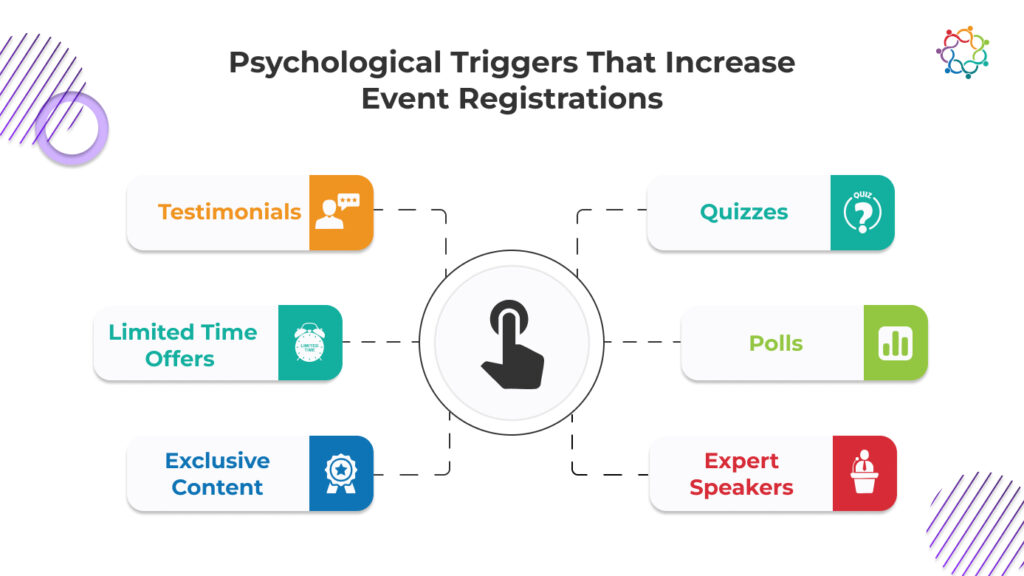
Understanding and leveraging psychological triggers can significantly boost event registrations. Here’s how:
People are more likely to register for an event if they see others doing the same. Social proof comes in many forms, including:
Displaying real-time registrations and attendee lists can reinforce social proof, making people feel like they’re part of a larger community.
People feel inclined to return a favor when they receive something of value. In event marketing, you can apply this principle by offering:
By giving before asking, you create a stronger incentive for attendees to register.
Limited availability drives demand. To implement scarcity and urgency, consider:
People trust industry leaders and experts. Establish credibility by:
Small commitments lead to larger commitments. Engage potential attendees early by:
Once attendees invest in small actions, they’re more likely to complete the registration process.
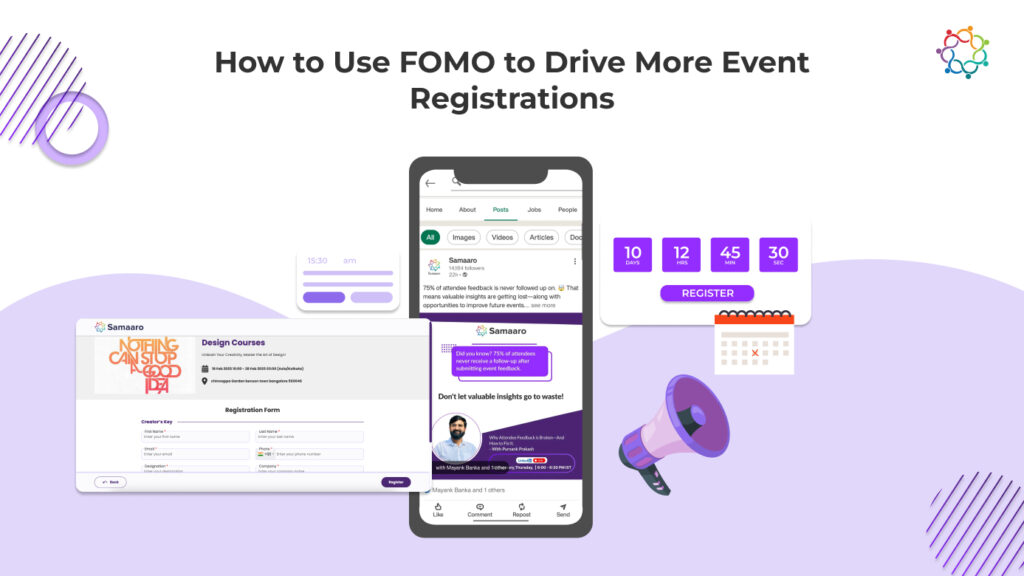
Fear of missing out (FOMO) is a powerful motivator. Event technology can amplify FOMO by creating a buzz around your event.
Showcasing real-time registration numbers on the event page signals high demand and encourages sign-ups.
Gated content, invite-only sessions, and private networking groups create exclusivity, making attendees feel special.
Dynamic seat availability indicators (e.g., “Only 10 seats left!”) prompt quicker registrations.
AI-powered personalized event highlights and interactive content (like Q&A sessions with speakers) drive interest.
Encouraging past attendees to share experiences using event-specific hashtags builds credibility and anticipation.
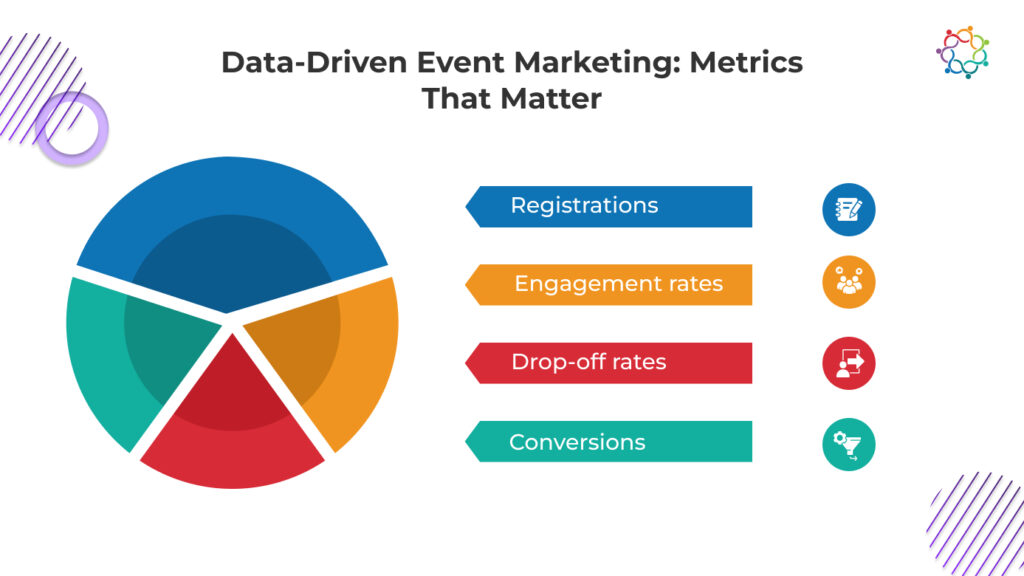
Data-driven decision-making enhances event marketing effectiveness. Here’s how data analytics can help:
Tracking registration trends, drop-off points, and engagement levels helps refine marketing strategies.
Experiment with different email subject lines, CTA buttons, and landing page designs to determine what drives conversions.
Using AI-powered recommendations, tailor event content based on attendee preferences and past behavior.
Track heatmaps, dwell time, and interaction data to optimize event content and session formats.
Forecasting registration numbers and attendance rates allows better resource allocation and event planning.
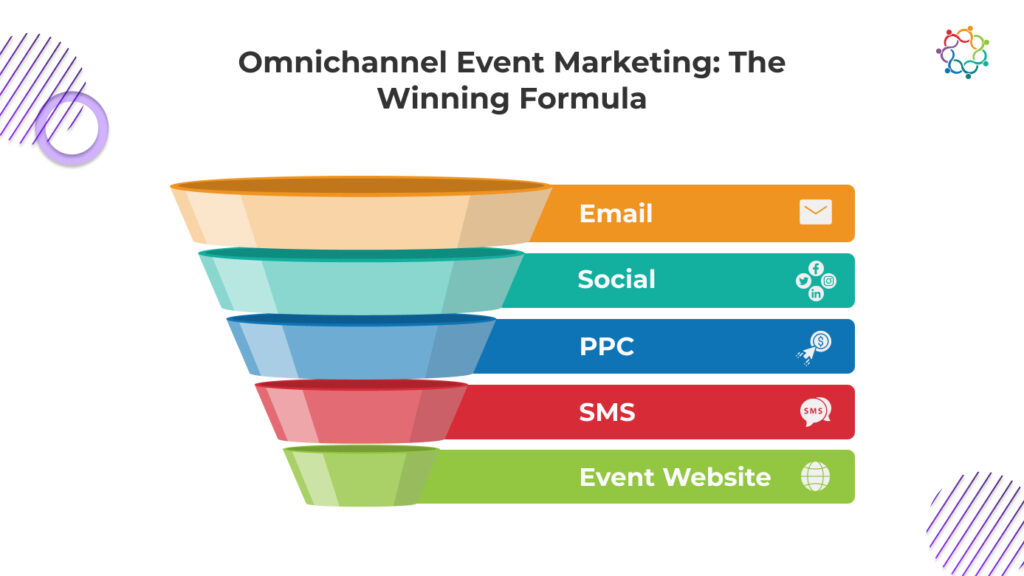
A multi-channel marketing approach ensures maximum reach and engagement. Here’s how to integrate different channels:
Successful event marketing combines psychology, data analytics, and omnichannel strategies. By leveraging social proof, urgency, and personalization, brands can drive higher event attendance.
Samaaro’s event marketing platform integrates these best practices, offering AI-powered analytics, engagement tools, and automated workflows to optimize campaigns. From personalized attendee journeys to real-time engagement tracking, our platform empowers brands to craft high-impact events.
Want to elevate your next event marketing campaign? Explore Samaaro’s solutions today.
Event marketing isn’t what it used to be. Gone are the days when a few well-placed ads and email blasts could guarantee a packed venue. Today, attention is scarce, competition is fierce, and capturing your audience’s interest requires a more intelligent, tech-driven approach.
So, how do you cut through the noise and make your event impossible to ignore in 2025? Let’s go beyond the obvious and explore innovative event awareness strategies for 2025 that leverage AI, data, and social media in ways that truly move the needle.
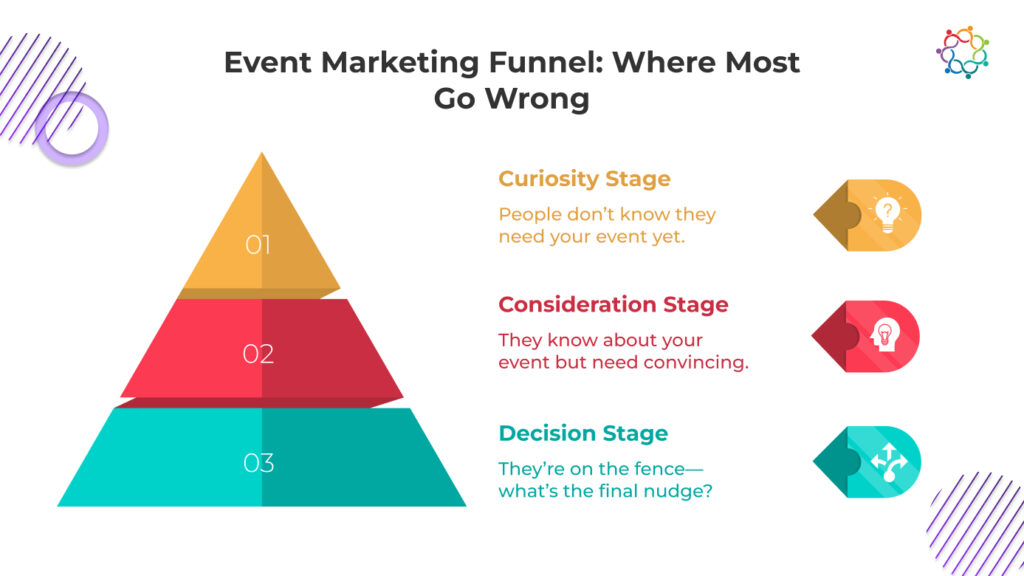
Most event marketers focus too much on the bottom of the funnel—pushing last-minute registrations, discounts, and urgent CTAs. But awareness begins much earlier, and getting this stage right determines how much you’ll struggle (or not) later.
Think of the event marketing funnel in three stages:
Instead of relying on generic promotions, your goal is to craft a strategy that nurtures curiosity, builds credibility, and naturally leads to conversion.
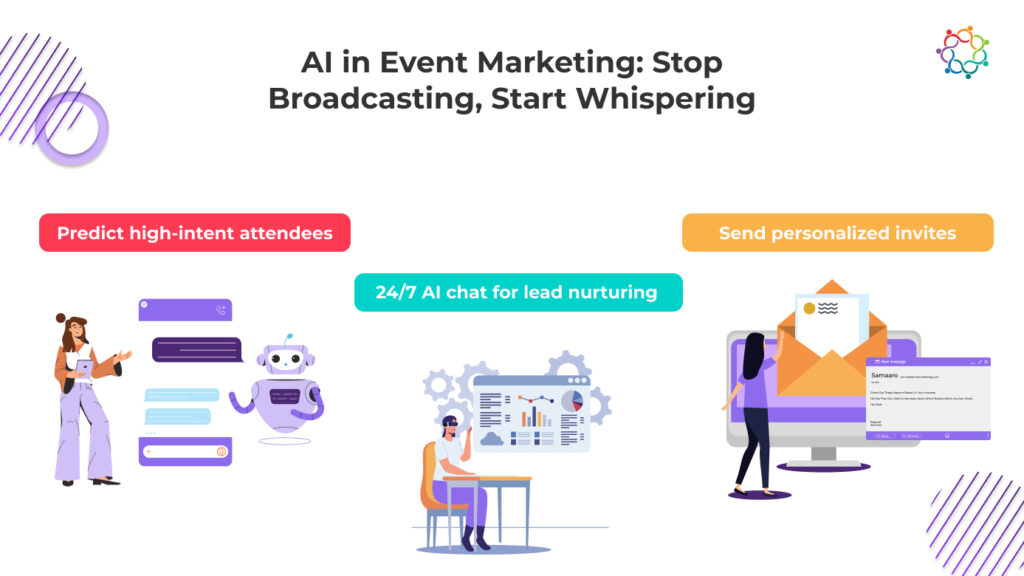
Most marketers still treat event promotion like a megaphone. But people engage with content that feels like a one-on-one conversation, not a mass advertisement.
Example: Instead of blasting a generic “Register Now” email, AI can help segment attendees based on interests. A CMO might receive an invite focused on networking with industry leaders, while a product manager might get insights on product showcases.
Posting a countdown and hoping for registrations? That doesn’t work anymore. Social media should create conversations, not just awareness.
Example: If your event is about AI in marketing, run a poll: “What’s your biggest challenge with AI? a) Personalization b) Scaling Content c) Ethics” and use the responses to shape event sessions.
Most marketers think event engagement starts when the event begins. Wrong. It starts the moment someone interacts with your brand.
Example: If you’re hosting a B2B marketing summit, an AI-powered quiz could suggest: “Based on your responses, these 3 sessions are perfect for you.” That’s far more compelling than a generic event agenda.
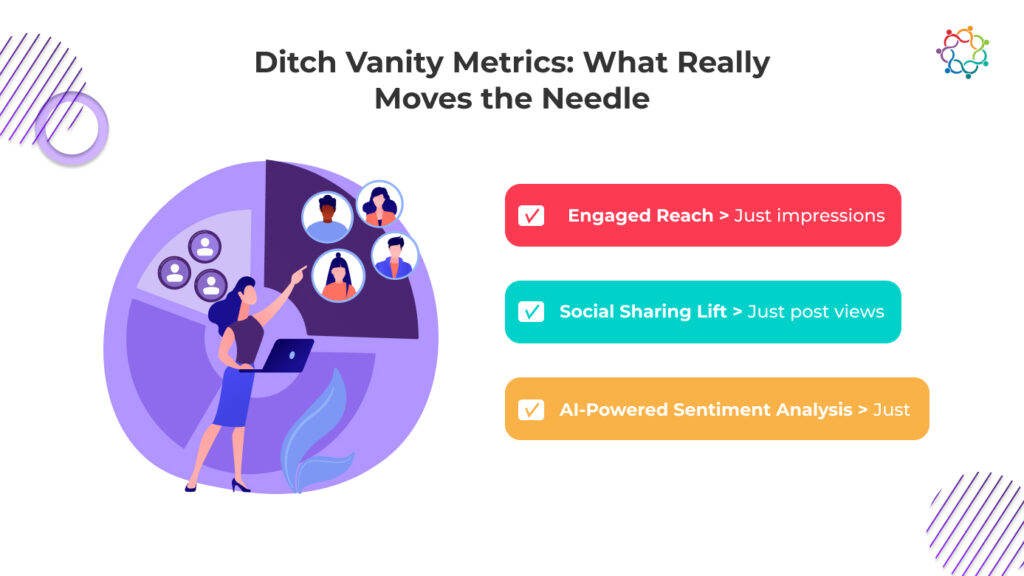
Many marketers fall into the trap of tracking impressions and clicks, but these numbers mean nothing if they don’t lead to registrations. Focus on actionable metrics that directly correlate to event success:
Example: If 50,000 people visited your event page but only 500 registered, AI can analyze what’s stopping the other 49,500—whether it’s unclear messaging, poor CTAs, or an unattractive ticketing structure.
Awareness is no longer about being loud—it’s about being strategic, relevant, and data-driven.
Samaaro helps brands navigate this shift with AI-powered audience insights, dynamic social amplification tools, and interactive engagement features that make event promotions feel personal, not generic. Whether you’re looking to refine your funnel, leverage AI for better targeting, or create meaningful social engagement, Samaaro gives you the toolkit to maximize event success.
Employees are the backbone of any organization, and their engagement significantly impacts a company’s success. Engaged employees are more motivated, productive, and loyal to their organizations. However, achieving and maintaining high levels of employee engagement can be challenging, especially in a fast-paced work environment.
Enter micro-events: small, focused gatherings designed to foster meaningful connections and create memorable experiences. These events are not just about celebrations but are tools for enhancing employee morale, team collaboration, and overall productivity. This blog explores how micro-events can become a cornerstone of your employee engagement strategy and how Samaaro can help you plan these events effectively.
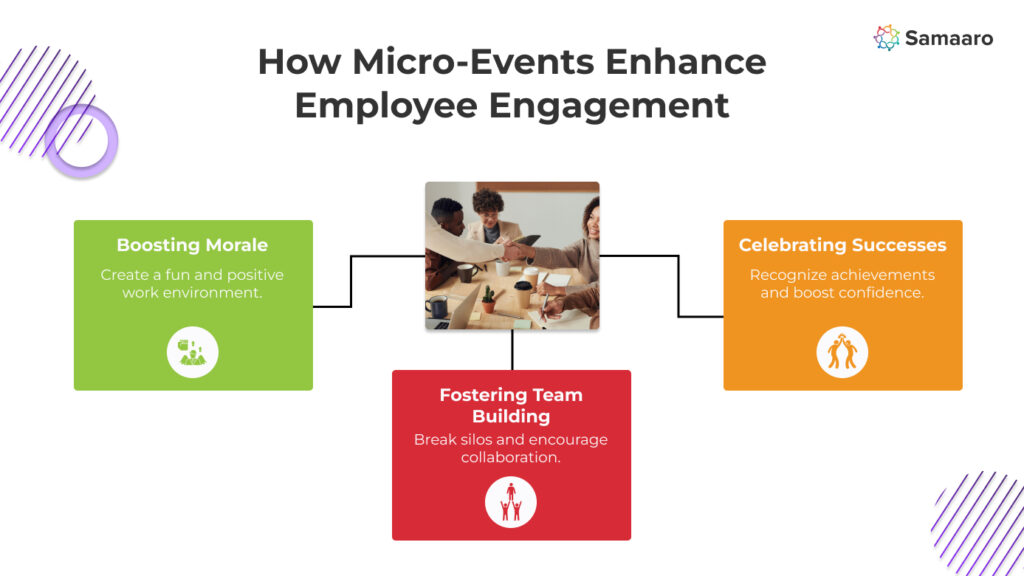
Happy employees are productive employees. Micro-events offer a fantastic way to uplift the mood in the workplace and create a positive environment. A well-timed event can remind employees that their efforts are valued, especially during stressful or high-pressure periods.
Examples of morale-boosting micro-events include:
Recognition plays a critical role in boosting morale. Using micro-events to highlight individual contributions or team efforts ensures employees feel seen and appreciated, fueling their motivation to perform even better.
Micro-events also serve as excellent platforms for team-building activities. Unlike larger gatherings, these intimate settings allow employees to connect on a deeper level, fostering genuine relationships. Team-building micro-events are especially effective in breaking down departmental silos and encouraging cross-functional collaboration.
Examples of team-building micro-events include:
These events not only enhance collaboration but also help employees develop trust and mutual respect, which are essential for a cohesive work environment.
Micro-events are a wonderful way to celebrate milestones and achievements, both big and small. Recognizing accomplishments reinforces a culture of success and motivates employees to strive for excellence.
Examples of celebratory micro-events include:
By celebrating successes, you show employees that their contributions matter, encouraging them to take ownership of their roles.
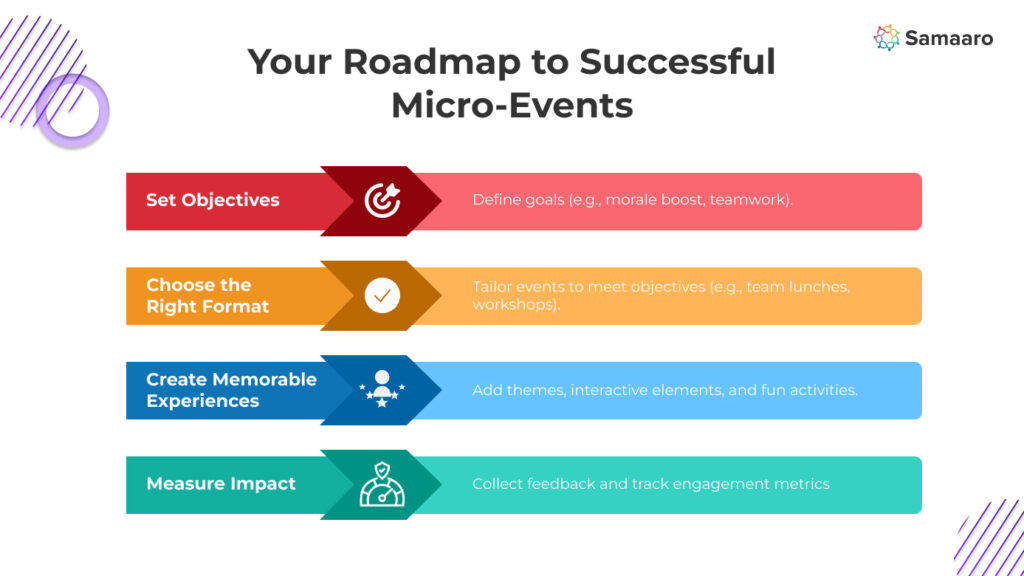
Every micro-event should have a purpose. Whether it’s to recognize achievements, build stronger teams, or simply boost morale, having a clear objective ensures the event is impactful. For instance, a team lunch might aim to improve interdepartmental communication, while a project launch celebration could focus on reinforcing a sense of accomplishment.
The format of your micro-event should align with its goals and your employees’ preferences. For example, if the goal is team building, a collaborative activity like a workshop or volunteer day might be ideal. On the other hand, if the objective is to boost morale, an appreciation event or casual gathering might be more appropriate.
Micro-events, while small in scale, should leave a lasting impact. Incorporate interactive elements, unique themes, or surprise activities to keep employees engaged. Personalized touches, such as customized invitations or tailored recognition, can make the experience even more special.
No engagement strategy is complete without measurement. Gather feedback from employees to understand what they enjoyed and what could be improved. Additionally, track metrics like employee satisfaction scores, attendance rates, and post-event engagement to gauge the event’s success.
Samaaro provides tools to simplify this process, enabling you to analyze event data and measure its impact on employee engagement.
Micro-events are a powerful tool for fostering employee engagement, boosting morale, and enhancing productivity. They create opportunities for meaningful connections, celebrate achievements, and encourage collaboration in ways that traditional large-scale events cannot.
By prioritizing employee engagement and incorporating micro-events into your workplace culture, you can create a positive and productive environment where employees feel valued and motivated to contribute their best.
Samaaro, an AI-powered event marketing platform, can assist you at every stage of micro-event planning—from setting objectives and sourcing venues to managing communications and analyzing results. Ready to transform your workplace with impactful micro-events? Schedule a demo with Samaaro today and see how we can help you create unforgettable experiences for your team.
In the world of event planning, securing the right speakers can be the cornerstone of your event’s success. Great speakers not only captivate your audience but also elevate the reputation of your event, making it memorable for years to come. But where do you find these industry leaders, thought-provoking experts, or inspiring storytellers?
Enter LinkedIn—the ultimate networking platform that doubles as a powerful tool for speaker sourcing. With over 900 million users from diverse industries, LinkedIn offers a treasure trove of potential speakers who can align perfectly with your event’s goals.
Here’s how you can leverage LinkedIn to find and secure top-tier speakers for your events.
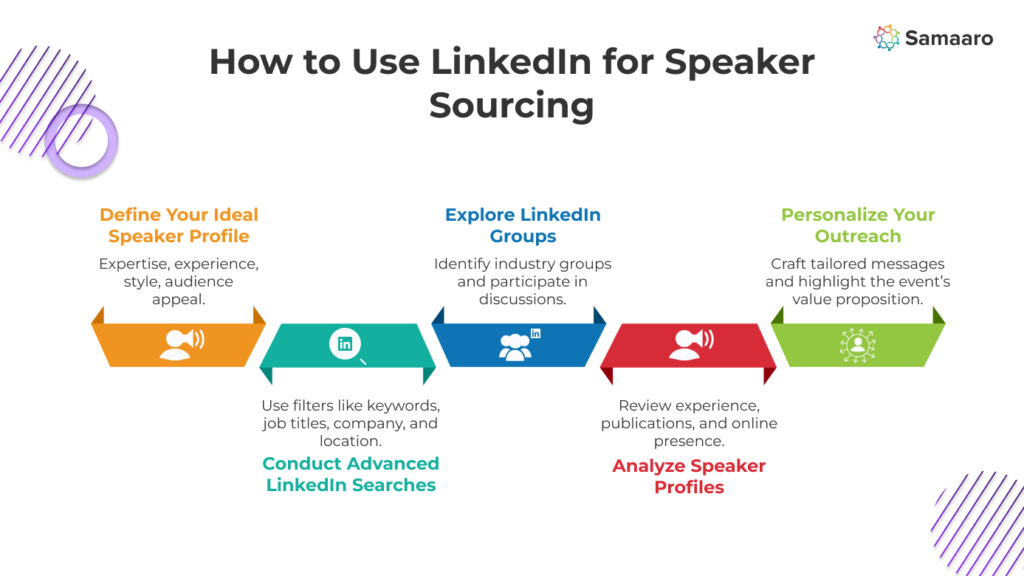
Before diving into LinkedIn’s vast network, it’s essential to define the kind of speaker you’re looking for.
For example, if your event is about AI in marketing, you might look for a seasoned AI professional who has experience delivering case studies or industry trends in an engaging way.
LinkedIn’s search functionality is a game-changer when it comes to finding specific profiles.
“Data Scientist” AND “Conference Speaker” AND “Marketing” AND “Location: ”
These targeted searches will help you uncover profiles of professionals who are not only experts in their field but also have a history of speaking at similar events.
LinkedIn groups are a goldmine for identifying potential speakers.
Once you identify potential speakers, delve deeper into their LinkedIn profiles.
This analysis will help you evaluate whether they’re a good fit for your event and capable of captivating your audience.
Reaching out to potential speakers requires a thoughtful approach.
Example Outreach Message:
Hi ,
I’ve been following your work on , and I’m impressed by your insights on . I’m organizing , focused on , and believe your expertise would add incredible value to our audience.
We would be honored to have you speak on . The event will take place on in , with an expected audience of .
Please let me know if you’d be open to discussing this further—I’d love to explore how we can collaborate!
Warm regards,
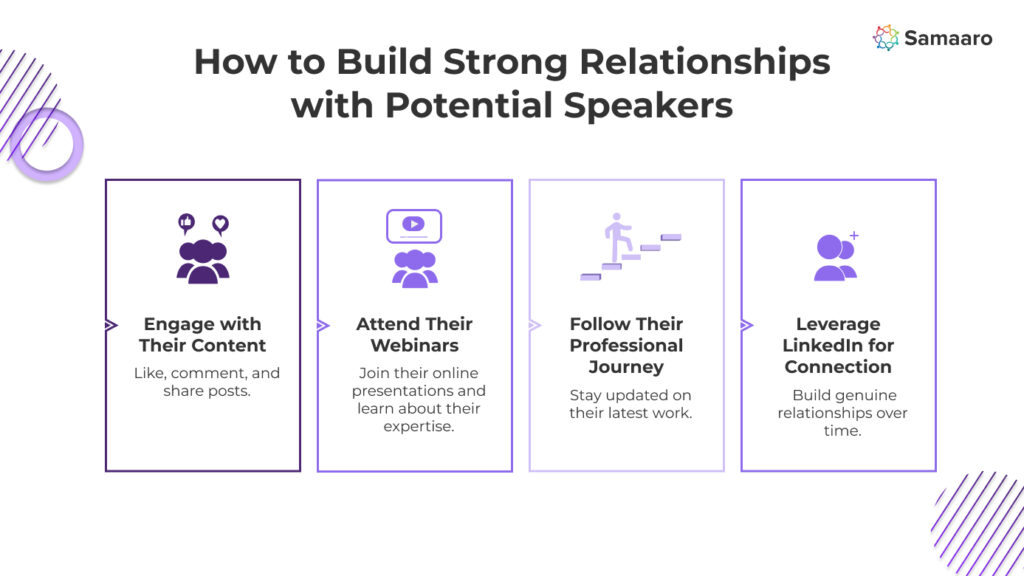
Successful speaker sourcing goes beyond just outreach; it’s about building genuine relationships.
By fostering a relationship, you not only increase the likelihood of securing them as a speaker but also build a lasting professional connection.
Securing top-tier speakers for your event requires more than just sending out invitations—it’s about crafting a strategic and respectful outreach process that sets the tone for a professional relationship. Here are some detailed tips to ensure your speaker outreach campaign is successful:
Finding the right speakers can take time, and not every outreach attempt will receive an immediate response. Here’s how to balance patience with persistence:
Example Follow-Up Message:
“Hi , I hope this message finds you well. I wanted to follow up on my earlier email about . We would be honored to have you speak at our event, and I’m happy to answer any questions or discuss details further. Let me know if there’s a good time to connect!”
Every interaction with potential speakers should reflect your professionalism and respect for their time and expertise. Consider these best practices:
Example Initial Outreach Message:
“Hi , I’m , at . We’re organizing on , which focuses on . Given your expertise in , we believe you’d be a perfect fit to inspire our audience of . We’d love to discuss this opportunity further and hear your thoughts. Please let me know if you’d be interested in exploring this!”
Efficient tracking of your outreach efforts helps you stay organized and ensures no potential speaker is overlooked. Here’s how to set up a system:
Example Spreadsheet Columns:
Speakers, especially established ones, may have specific preferences or requirements. Being flexible in your approach can help build trust and encourage them to work with you. Consider the following:
Example Flexibility Message:
“We’re happy to work around your availability and discuss how we can make this opportunity mutually beneficial. Please let us know if there are specific session formats or topics you’re passionate about, and we’ll tailor the event accordingly.”
Speakers are more likely to accept an invitation if they understand the value of participating in your event. Clearly articulate what’s in it for them:
Example Value Proposition Message:
“Our event attracts attendees, including . This is a great opportunity to share your expertise and connect with like-minded professionals. We’d also be happy to provide professional recordings of your session for your use.”
By following these tips, you can create an outreach campaign that is professional, strategic, and speaker-friendly. The right approach not only helps you secure top speakers but also builds lasting relationships that can benefit future events.
LinkedIn is a treasure trove of opportunities for event planners, offering access to a global network of professionals and thought leaders. By defining your ideal speaker profile, leveraging advanced search techniques, and engaging meaningfully with potential speakers, you can secure impactful speakers who elevate your event.
Ready to take your speaker sourcing to the next level? Platforms like Samaaro can help streamline the process, from personalized outreach to managing speaker relationships. Book a demo or start your free trial to see how we can support your event planning journey!
In the realm of event marketing, email is still a key strategy for engaging attendees, increasing registrations, and delivering a great experience for attendees. As we enter 2025, we will see the prominent use of trigger-based emails by marketers to communicate with their audience. Trigger-based emails are automated, action-based emails, that will allow your emails to reach the right people at the right times, which will improve productivity and results.
This guide discusses the basics of trigger-based emails, offering tips and examples to help you succeed in using a strong marketing tactic.
Trigger-based emails are an email marketing strategy that utilizes automation to deliver very targeted and personalized emails. Trigger-based emails are sent automatically based on certain actions, activities, or rules you define, helping to ensure the emails are relevant and meaningful to recipients. Triggered emails are a step above a traditional email blast that sends the same messaging to a long list of attendees with no real focus. Auto-actioned emails are specific and contextual, which empowers the deliverability of the action.
Trigger-based emails function by tracking user’s interactions or any other milestone with the appropriate output. For example:
The beauty of trigger-based emails lies in their alignment with the recipient’s journey. Here’s why they stand out:
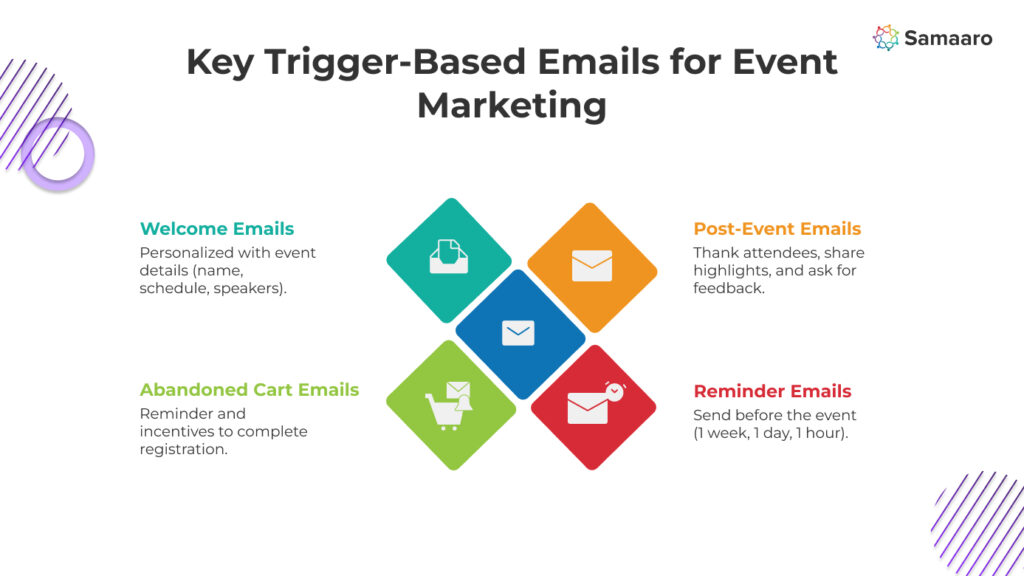
To illustrate their potential, here are some practical examples:
In the dynamic world of events, timing and communication are critical to success. Trigger-based emails ensure that every touchpoint, from registration to post-event follow-up, is strategically aligned with the attendee’s needs. Whether boosting registrations, reducing cart abandonment, or fostering post-event loyalty, trigger-based emails are a vital tool in any event marketer’s arsenal.
By leveraging trigger-based emails, you can transform your email marketing strategy into a personalized, automated, and highly efficient system that builds stronger connections with your audience while driving measurable results.
Welcome emails play a vital role in setting expectations and providing attendees with the information they need to start their event journey. They establish a positive first impression and ensure attendees feel valued.
When Triggered: Upon registration or ticket purchase.
What to Include:
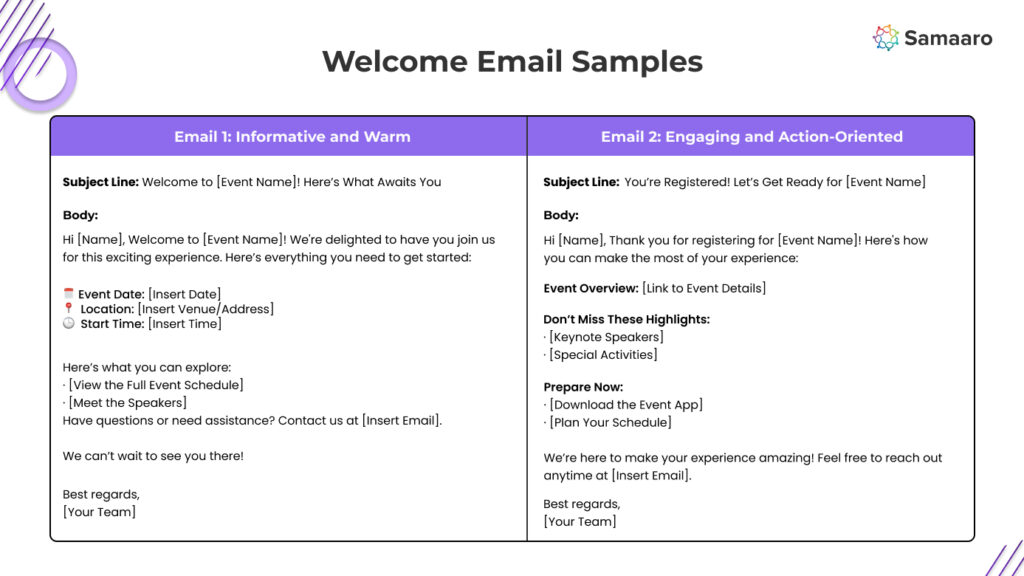
Cart abandonment emails are a gentle nudge to remind potential attendees to complete their ticket purchase. These emails should highlight the value of the event and create urgency to encourage action.
When Triggered: When a user leaves items in their shopping cart without completing registration.
What to Include:
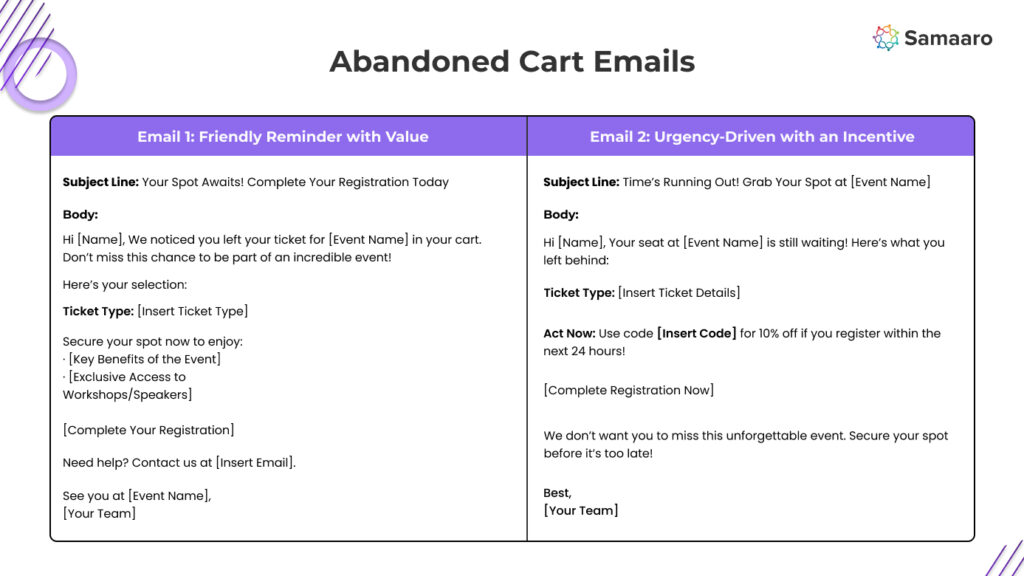
Reminder emails keep attendees informed and excited as the event approaches. These emails ensure attendees are well-prepared and don’t miss out.
When to send: 1 week, 1 day, and 1 hour before the event.
What to Include:
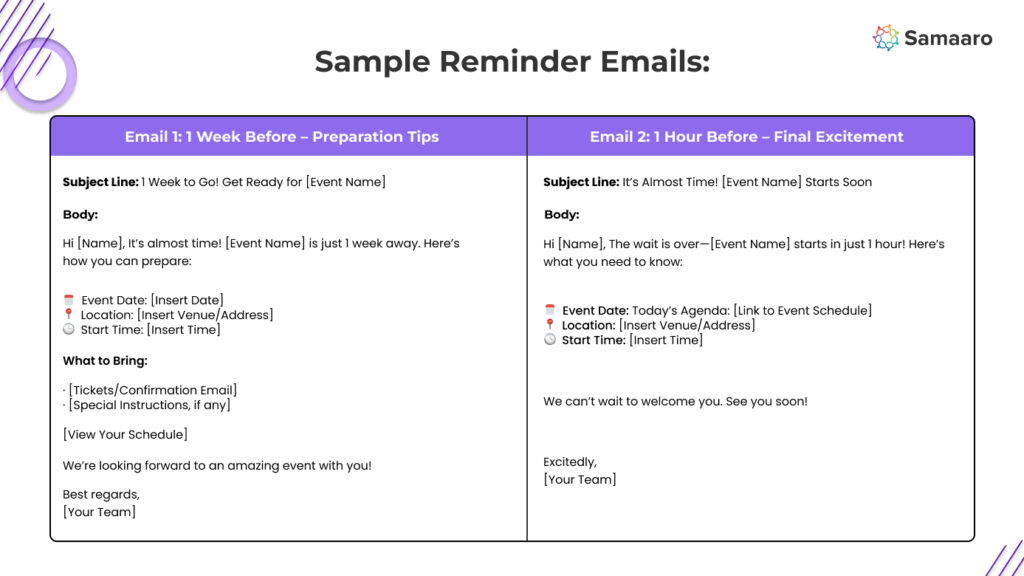
Post-event emails allow you to thank attendees, share highlights, and gather valuable feedback. They’re also an excellent opportunity to nurture relationships and promote future events.
When to send: Within 24–48 hours after the event.
What to Include:
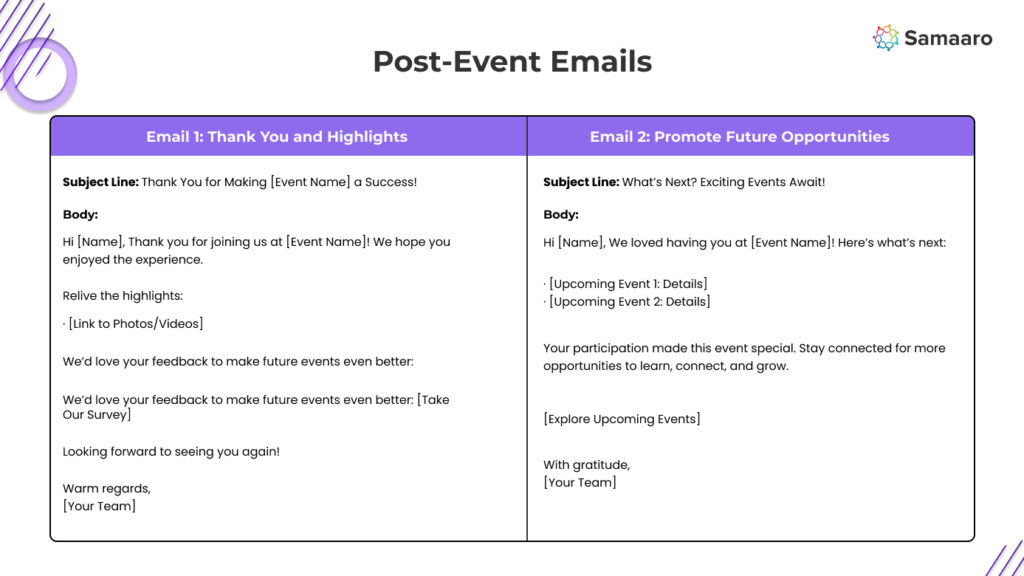
These trigger-based emails not only enhance the attendee experience but also ensure effective engagement throughout the event lifecycle.
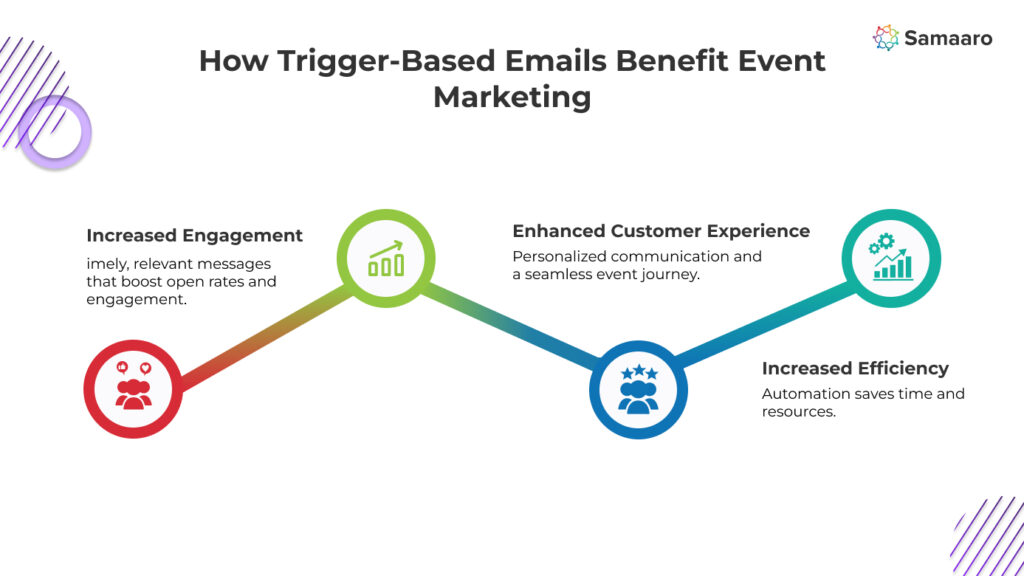
Trigger-based emails offer a range of advantages that make them indispensable for event marketers. Let’s dive deeper into their benefits:
One of the standout benefits of trigger-based emails is their ability to capture attention. These emails are sent in response to specific actions or behaviors, ensuring the message feels relevant to the recipient. When attendees receive an email shortly after registering, leaving their cart, or completing another action, they are more likely to open and engage with it.
How It Helps:
Trigger-based emails are a powerful tool for driving conversions. For instance, abandoned cart emails serve as a gentle reminder for prospective attendees who didn’t complete their ticket purchase. By addressing potential barriers—like confusion about pricing or last-minute hesitation—and offering solutions like discounts or extra perks, these emails help secure registrations that might otherwise be lost.
How It Helps:
Timely and personalized communication makes attendees feel valued. For example, a welcome email with all the essential details ensures attendees are well-prepared for the event. Similarly, a post-event email that thanks participants and shares highlights fosters a sense of appreciation and belonging.
How It Helps:
How It Helps:
Trigger-based emails rely on automation, which means your team can focus on higher-value tasks instead of manual follow-ups. Once workflows are set up, emails are sent automatically based on predefined triggers, ensuring consistent communication without extra effort.
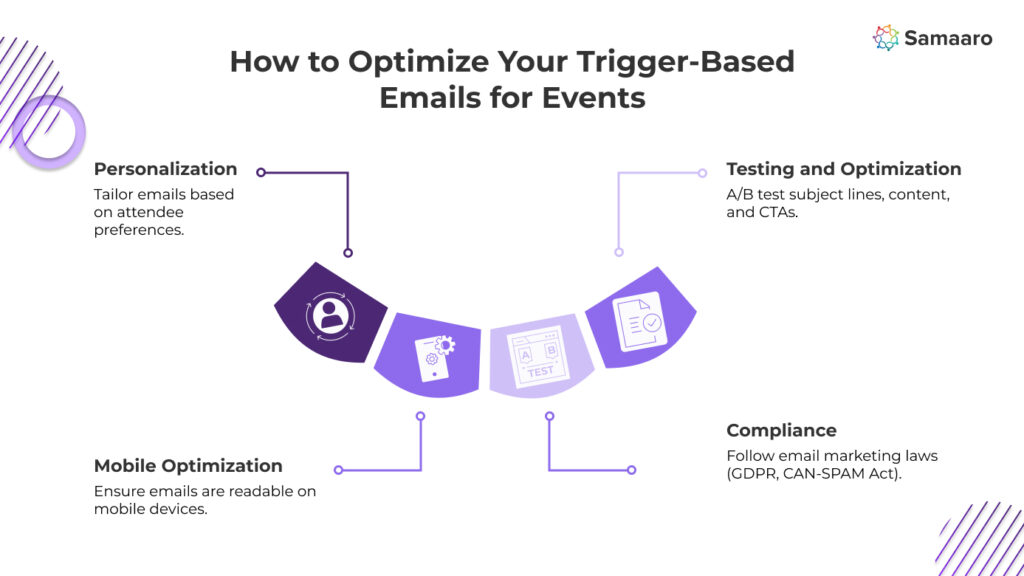
To maximize the effectiveness of trigger-based emails, it’s important to follow these best practices:
Personalization goes beyond adding the recipient’s name to an email. Leverage data to tailor the content to individual preferences and actions. For instance, include the specific ticket type they purchased or recommend sessions based on their interests.
Tips for Personalization:
In today’s mobile-first world, many recipients will open emails on their smartphones. If your emails aren’t optimized for mobile, you risk losing engagement and conversions.
How to Optimize for Mobile:
A/B testing is essential for refining your email campaigns. Experiment with different elements like subject lines, email layouts, imagery, and CTAs to identify what resonates best with your audience.
Testing Ideas:
Respecting privacy and adhering to email marketing regulations is critical. Failure to comply can lead to penalties and harm your brand reputation.
Key Compliance Tips:
Trigger-based emails are a game-changer in event marketing. Unlike traditional email campaigns, they are highly targeted, personalized, and action-driven, ensuring your audience receives the right message at the right time. From welcoming attendees to keeping them engaged post-event, these emails help marketers streamline communication and create a seamless attendee experience.
Why They Matter:
Get Started Today:
By implementing trigger-based email campaigns, you can elevate your event marketing strategy in 2025. Whether you’re a seasoned marketer or just getting started, platforms like Samaaro can help automate and personalize these campaigns, ensuring your event communication is both efficient and impactful.
Ready to transform your email marketing strategy? Dive into the world of trigger-based emails and watch your events thrive!
Connect with Samaaro today—book a demo or start your free trial to experience how our platform can help you craft and send personalized, automated trigger-based emails for your events.

Built for modern marketing teams, Samaaro’s AI-powered event-tech platform helps you run events more efficiently, reduce manual work, engage attendees, capture qualified leads and gain real-time visibility into your events’ performance.
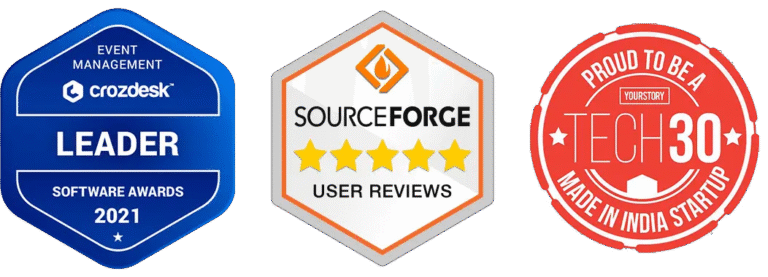
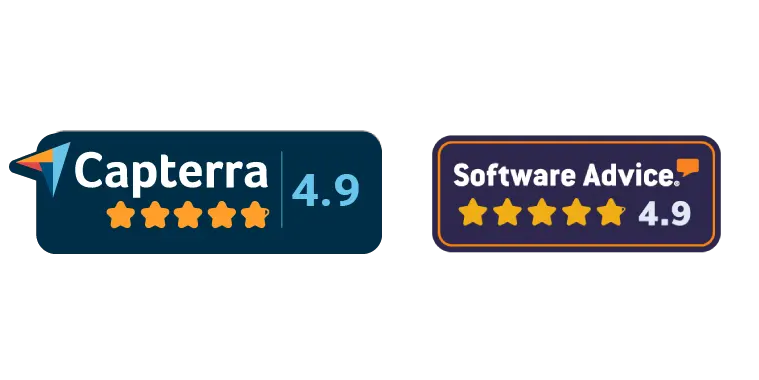
© 2025 — Samaaro. All Rights Reserved.